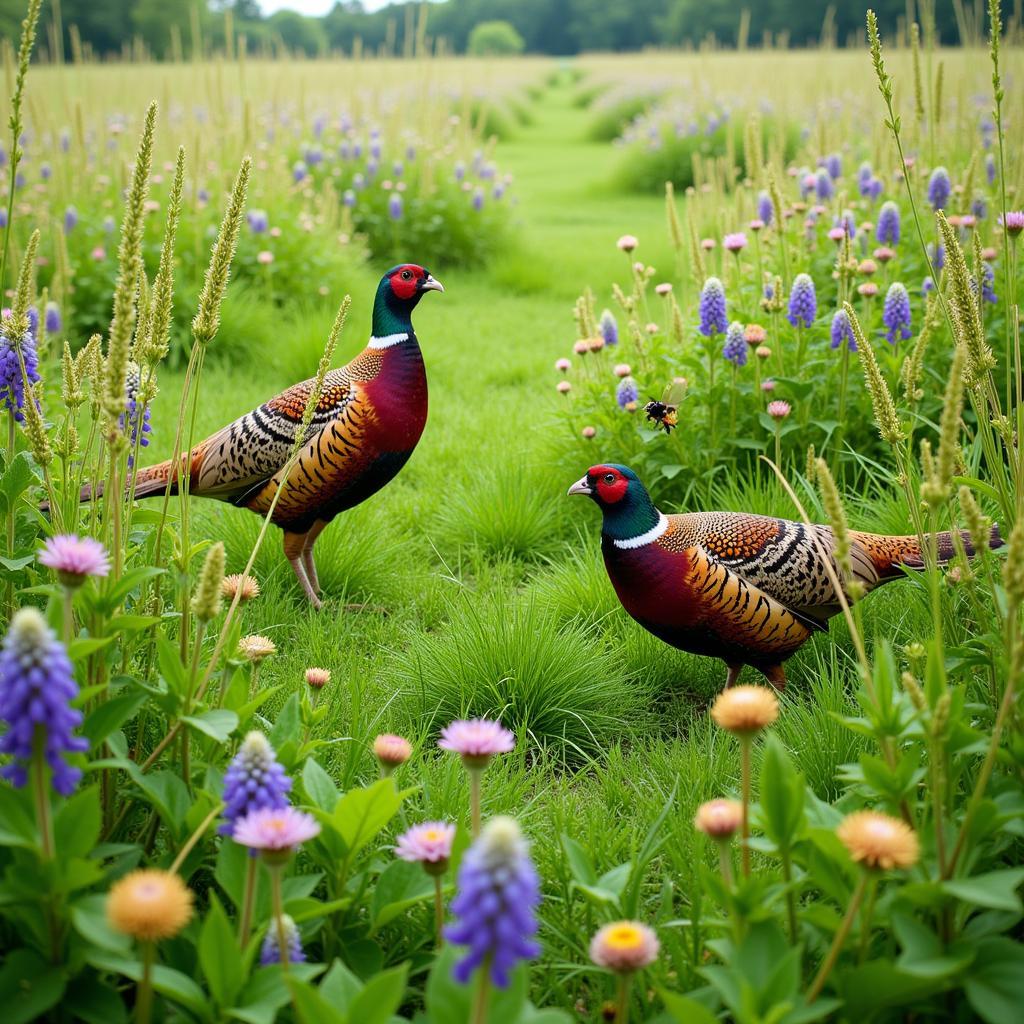Pheasant Food Plot Seed. These three little words can make all the difference between a thriving pheasant population and a disappointing hunting season. Whether you’re a seasoned hunter looking to improve your land or a beginner hoping to attract these magnificent birds, selecting the right seed is crucial.
Understanding Pheasant Food Habits
Before diving into the world of seeds, let’s get to know our feathered friends a little better. Pheasants are primarily ground birds, foraging for their meals in fields, meadows, and along forest edges. Their diet changes throughout the year, adapting to the available food sources.
What do pheasants eat?
Pheasants are omnivores, meaning they enjoy both plant and animal matter. Their diet consists of:
- Seeds: A staple food source, especially during fall and winter.
- Grains: Corn, wheat, and milo are particularly appealing.
- Insects: A vital source of protein for chicks and growing birds.
- Greens: Tender shoots, leaves, and buds provide essential nutrients.
Key Factors for Choosing Pheasant Food Plot Seed
Selecting the right seed mix is like putting together a delicious and nutritious meal for your pheasants. Here’s what to consider:
1. Your Region and Soil Type
Different plants thrive in different climates and soil conditions. What works wonders in the Midwest might not be suitable for the Northeast. Research seed varieties that are well-suited to your specific area.
2. Time of Year
- Spring and Summer: Opt for seed mixes that include legumes like clover and alfalfa, which provide protein and attract insects.
- Fall and Winter: Focus on grains like corn, wheat, and sorghum, which offer energy-rich sustenance during the colder months.
3. Pheasant Age and Needs
- Chicks: Insect-attracting plants like clover are crucial for their growth.
- Adult Birds: A balanced mix of seeds, grains, and greens will keep them healthy and satisfied.
 Vibrant Spring Food Plot for Pheasants
Vibrant Spring Food Plot for Pheasants
Popular Pheasant Food Plot Seed Options
Now that you understand the basics, let’s explore some popular seed choices:
1. Clover: A versatile legume that attracts insects, provides nitrogen to the soil, and offers nutritious forage for pheasants.
2. Alfalfa: Similar to clover, alfalfa is a protein-rich option that thrives in well-drained soil.
3. Wheat: A hardy grain that provides essential carbohydrates and serves as excellent winter cover for pheasants.
4. Corn: A pheasant favorite, corn offers high energy content and can be planted in the spring or as a late-summer supplement.
5. Milo (Sorghum): A drought-tolerant grain that provides food and cover during the fall and winter.
Expert Insight: “Remember, diversity is key,” says Dr. Emily Carter, a wildlife biologist specializing in upland game birds. “A blend of different seed types will attract a wider range of insects and provide pheasants with a balanced diet throughout the year.”
 Winter Food Plot Sustaining Pheasants
Winter Food Plot Sustaining Pheasants
Creating and Maintaining Your Pheasant Food Plot
Choosing the right seed is only the first step. Here’s how to create and maintain a thriving food plot:
- Soil Testing: Determine your soil type and pH level to choose compatible plants and amendments.
- Site Preparation: Clear existing vegetation and till the soil to create a suitable seedbed.
- Planting: Follow the recommended seeding rates and depths for your chosen seed mix.
- Weed Control: Regularly monitor and control weeds to prevent competition with your food plot plants.
- Fertilization: Provide necessary nutrients based on your soil test results to promote healthy plant growth.
Beyond Food: Creating a Pheasant Paradise
Food is essential, but it’s not the only factor in attracting pheasants. To create a haven for these beautiful birds:
- Provide Cover: Plant shrubs, grasses, and trees to offer nesting sites, protection from predators, and shelter from harsh weather.
- Water Sources: Ensure access to clean water through ponds, streams, or bird baths.
- Limit Disturbances: Minimize human activity and noise pollution in and around nesting and feeding areas.
Conclusion
Choosing the best pheasant food plot seed is a rewarding endeavor that can significantly impact the health and abundance of these magnificent birds. By understanding their dietary needs, considering your regional factors, and creating a welcoming habitat, you can enjoy the satisfaction of providing for pheasants while contributing to their conservation. So, roll up your sleeves, grab your seeds, and start creating a pheasant paradise!
FAQs about Pheasant Food Plot Seed
1. When is the best time to plant pheasant food plot seed?
The ideal planting time depends on your chosen seed mix and your region. Spring and early fall are generally favorable times.
2. How large should my pheasant food plot be?
The size can vary, but aim for a plot that’s at least 1/4 to 1/2 acre to provide sufficient food and cover.
3. Can I mix different types of pheasant food plot seed?
Yes, creating a diverse seed mix is highly recommended to provide a balanced diet and attract a wider range of insects.
4. How long does it take for pheasant food plot seed to grow?
Germination and growth rates vary depending on the seed type and environmental conditions, but most seeds will sprout within 7-14 days.
5. Where can I buy pheasant food plot seed?
You can find a variety of seed mixes at local farm supply stores, online retailers specializing in wildlife seed, and some garden centers.
Do you have other questions about creating the perfect habitat for your pheasants? Check out our article about game bird food for more helpful tips and information!
For personalized advice and assistance in choosing the best pheasant food plot seed for your needs, don’t hesitate to contact us. Our team at Mina Cones is dedicated to helping you create a thriving environment for these beautiful birds. Reach us at 02437655121 or minacones@gmail.com. We’re available 24/7 to answer your questions and provide expert guidance!